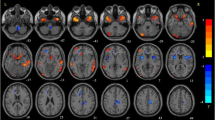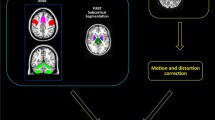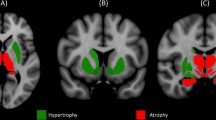Abstract
The etiopathogenesis of essential tremor (ET) is still debated, since the predominant role of circuit dysfunction or brain degenerative changes has not been clearly established. The relationship with Parkinson’s Disease (PD) is also controversial and resting tremor occurs in up to 20 % of ET. We investigated the morphological and functional changes associated with ET and we assessed potential differences related to the presence (ET+R) or absence (ET−R) of resting tremor. 32 ET patients (18 ET+R; 14 ET−R) and 12 healthy controls (HC) underwent 3T-MRI protocol including Spoiled Gradient T1-weighted sequence for Voxel-Based Morphometry (VBM) analysis and functional MRI during continuous writing of “8” with right dominant hand. VBM analysis revealed no gray and white matter atrophy comparing ET patients to HC and ET+R to ET−R patients. HC showed a higher BOLD response with respect to ET patients in cerebellum and other brain areas pertaining to cerebello-thalamo-cortical circuit. Between-group activation maps showed higher activation in precentral gyrus bilaterally, right superior and inferior frontal gyri, left postcentral gyrus, superior and inferior parietal gyri, mid temporal and supramarginal gyri, cerebellum and internal globus pallidus in ET−R compared to ET+R patients. Our findings support that the dysfunction of cerebello-thalamo-cortical network is associated with ET in absence of any morphometric changes. The dysfunction of GPi in ET+R patients, consistently with data reported in PD resting tremor, might suggest a potential role of this structure in this type of tremor.



Similar content being viewed by others
References
Louis ED, Frucht SJ, Rios E (2009) Intention tremor in essential tremor: prevalence and association with disease duration. Mov Disord 24:626–627
Singer C, Sanchez-Ramos J, Weiner WJ (1994) Gait abnormality in essential tremor. MovDisord 9:193–196
Helmchen C, Hagenow A, Miesner J et al (2003) Eye movement abnormalities in essential tremor may indicate cerebellar dysfunction. Brain 126(pt 6):1319–1332
Gitchel GT, Wetzel PA, Baron MS (2013) Slowed saccades and increased square wave jerks in essential tremor. Tremor Other Hyperkinet Mov (NY) 3. [pii]: tre-03-178-4116-2 (eCollection 2013)
Colebatch JC, Findley LJ, Frackowiak RS, Marsden CD, Brooks DJ (1990) Preliminary report: activation of the cerebellum in essential tremor. Lancet 336:1028–1030
Jenkins IH, Bain PG, Colebatch JG et al (1993) A positron emission tomography study of essential tremor: evidence for overactivity for cerebellar connections. Ann Neurol 34(1):82–90
Boecker H, Wills AJ, Ceballos-Baumann A et al (1996) The effect of ethanol alcohol responsive essential tremor: a positron emission tomography. Ann Neurol 39(5):650–658
Bucher SF, Seelos KC, Dodel RC, Reiser M, Oertel WH (1997) Activation mapping in essential tremor with functional magnetic resonance imaging. Ann Neurol 41(1):32–40
Benito-Leon J, Alvarez-Linera J, Hernandez-Tamames JA, Alonso-Navarro H, Jimenez-Jimenez FJ, Louis ED (2009) Brain structural changes in essential tremor: voxel-based morphometry at 3-Tesla. J Neurol Sci 287:138–142
Bagepally BS, Bhatt MD, Chandran V et al (2010) Decrease in cerebral and cerebellar gray matter in essential tremor: a voxel-based morphometric analysis under 3T MRI. J Neuroimaging 20:1–4
Louis ED, Faust PL, Vonsattel JP et al (2007) Neuropathological changes in essential tremor: 33 cases compared with 21 controls. Brain 130:3297–3307
Rajput AH, Robinson CA, Rajput ML, Robinson SL, Rajput A (2012) Essential tremor is not dependent upon cerebellar Purkinje cell loss. Parkinsonism Relat Disord 18(5):626–628
Fekete R, Jankovic J (2011) Revisiting the relationship between essential tremor and Parkinson’s disease. Mov Disord 26:391–398
Cohen O, Pullman S, Jurewicz E, Watner D, Louis ED (2003) Rest tremor in patients with essential tremor: prevalence, clinical correlates, and electrophysiologic characteristics. Arch Neurol 60:405–410
Diciotti S, Cecchi P, Ginestroni A et al. (2010) MR-compatible device for monitoring hand tracing and writing tasks in fMRI with an application to healthy subjects. Conc Magn Reson Imaging Part A 36A:139–152
Deuschl G, Bain P, Brin M (1998) Consensus statement of the Movement Disorder Society on Tremor. Ad Hoc Sci Comm Mov Disord 13(suppl 3):2–23
Fahn S, Tolosa E, Concepcion M (1993) Clinical rating scale for tremor. In: Jankovic J, Tolosa E (eds) Parkinson’s disease and movement disorders, 2nd edn. Williams and Wilkins, Baltimore, pp 271–280
Oldfield RC (1971) The assessment and analysis oh handedness: the Edinburgh inventory. Neuropsychologia 9(1):97–113
Ashburner J, Friston K (2000) Voxel-based morphometry–the methods. Neuroimage 11:805–821
Smith SM, Zhang Y, Jenkinson M et al (2002) Accurate, robust and automated longitudinal and cross-sectional brain change analysis. Neuroimage 17:479–489
Zhang Y, Brady M, Smith S (2001) Segmentation of brain MR images through a hidden Markov random field model and the expectation maximization algorithm. IEEE Trans Med Imaging 20:45–57
Mazziotta JC, Toga AW, Evans A, Fox P, Lancaster J (1995) A probabilistic atlas of the human brain: theory and rationale for its development. Neuroimage 2:89–101
Jenkinson M, Smith SM (2001) A global optimisation method for robust affine registration of brain images. Med Image Anal 5:143–156
Jenkinson M, Bannister PR, Brady JM, Smith SM (2002) Improved optimisation for the robust and accurate linear registration and motion correction of brain images. Neuroimage 17:825–841
Andersson JLR, Jenkinson M, Smith S (2007) Non-linear registration, aka Spatial normalisation. FMRIB Technical Report TR07JA2 2007 from www.fmrib.ox.ac.uk/analysis/techrep
Smith SM, Nichols TE (2009) Threshold-free cluster enhancement: addressing problems of smoothing, threshold dependence and localisation in cluster inference. Neuroimage 44:83–98
Draganski B, Ashburner J, Hutton C et al (2011) Regional specificity of MRI contrast parameter changes in normal ageing revealed by voxel-based quantification (VBQ). Neuroimage 55:1423–1434
Glickstein M, Sultan F, Voogd J (2011) Functional localization in the cerebellum. Cortex 47:59–80
Beckmann CF, Smith S, Jenkinson M (2003) General multi-level linear modelling for group analysis in FMRI. Neuroimage 20:1052–1063
Woolrich MW, Behrens TE, Beckmann CF, Jenkinson M, Smith SM (2004) Multilevel linear modelling for FMRI group analysis using Bayesian inference. Neuroimage 21:1732–1747
Oakes TR, Fox AS, Johnstone T, Chung MK, Kalin N, Davidson RJ (2007) Integrating VBM into the general linear model with voxelwise anatomical covariates. Neuroimage 34:500–508
Tzourio-Mazoyer N, Landeau B, Papathanassiou D et al (2002) Automated anatomical labeling of activations in SPM using a macroscopic anatomical parcellation of the MNI MRI single-subject brain. Neuroimage 15:273–289
Daniels C, Peller M, Wolff S et al (2006) Voxel-based morphometry shows no decreases in cerebellar grey matter volume in essential tremor. Neurology 67:1452–1456
Klein JC, Lorenz B, Kang JS et al (2011) Diffusion tensor imaging of white matter involvement in essential tremor. Hum Brain Mapp 32:896–904
Fang W, Lv F, Luo T et al. (2013) Abnormal regional homogeneity in patients with essential tremor revealed by resting-state functional MRI. 8(7):e69199. doi:10.1371/journal.pone.0069199 (print 2013)
Quattrone A, Cerasa A, Messina D et al (2008) Essential head tremor is associated with cerebellar atrophy: a volumetric and voxel-based morphometry MR imaging study. Am J Neuroradiol 29:1692–1697
Cerasa A, Messina D, Nicoletti G et al (2009) Cerebellar atrophy in essential tremor using an automated segmentation method. Am J Neuroradiol 30(6):1240–1243
Schnitzler A, Munks C, Butz M, Timmermann L, Gross J (2009) Synchronized brain network associated with essential tremor as revealed by magnetoencephalography. Mov Disord 24(11):1629–1635
Sudmeyer M, Pollok B, Hefter H et al (2006) Synchronized brain network underlying postural tremor in Wilson’s disease. Mov Disord 21(11):1935–1940
Timmermann L, Gross J, Dirks M, Volkmann J, Freund HJ, Schnitzler A (2003) The cerebral oscillatory network of parkinsonian resting tremor. Brain 126:199–212
Schnitzler A, Timmermann L, Gross J (2006) Physiological and pathological oscillatory networks in the human motor system. J Physiol Paris 99:3–7
Pollok B, Gross J, Dirks M, Timmermann L, Schnitzler A (2004) The cerebral oscillatory network of voluntary tremor. J Physiol 554:871–878
Gross J, Timmermann J, Kujala M et al (2002) The neural basis of the intermittent motor control in humans. Proc Natl Acad Sci USA 99:2299–2302
Popa T, Russo M, Vidailhet M et al (2013) Cerebellar rTMS stimulation may induce prolonged clinical benefits in essential tremor and subjacent changes in functional connectivity: an open label trial. Brain stim 6(2):175–179. doi:10.1016/j.brs.2012.04.009 Epub 2012 May 12
Contarino MF, Groot PF, van der Meer JN et al (2012) Is there a role for combined EMG-fMRI in exploring the pathophysiology of essential tremor and improving functional neurosurgery? PLoS One 7(10):e46234. doi:10.1371/journal.pone.0046234 (epub 2012 Oct 1)
Hua SE, Lenz FA, Zirh TA, Reich SG, Dougherty PM (1998) Thalamic neuronal activitycorrelated with essential tremor. J Neurol Neurosurg Psychiatry 64(2):273–276
Hua SE, Lenz FA (2005) Posture-related oscillations in human cerebellar thalamus in essential tremor are enabled by voluntary motor circuits. J Neurophysiol 93(1):117–127
Hellwig B, Haussler S, Schelter B et al (2001) Tremor-correlated cortical activity in essential tremor. Lancet 357:519–523
Raethjen J, Govindan RB, Kopper F et al (2007) Cortical involvement in the generation of essential tremor. J Neurophysiol 97:3219–3228
Dupuis MJ, Evrard FL, Jacquerye PG, Picard GR, Lermen OG (2010) Disappearance of essential tremor after stroke. Mov Disord 25(16):2884–2887
Raethjen J, Deuschl G (2012) The oscillating central network of Essential tremor. Clin Neurophysiol 123:61–64
Boecker H, Weindl A, Brooks DJ et al (2010) GABAergic dysfunction in essential tremor: an 11C-Flumazenil PET study. J Nucl Med 51:1030–1035
Gironell A, Figueiras FP, Pagonabarraga J et al (2012) Gaba and serotonin molecular neuroimaging in essential tremor: a clinical correlation study. Parkinsonism Relat Disord 18:876–880
Helmich RC, Janssen MJ, Oyen WJ, Bloem BR, Toni I (2011) Pallidal dysfunction drives a cerebellothalamic circuit into Parkinson tremor. Ann Neurol 69(2):269–281
Prodoehl J, Spraker M, Corcos D, Comella C, Vaillancourt D (2010) Blood oxygenation level-dependent activation in basal ganglia nuclei relates to specific symptoms in de novo Parkinson’s disease. Mov Disord 25(13):2035–2043
Hutchinson WD, Lozano AM, Tasker RR, Lang AE, Dostrovsky JO (1997) Identification and characterization of neurons with tremor-frequency activity in human globus pallidus. Exp Brain Res 113:557–563
Hirsch EC, Mouatt A, Faucheux B et al (1992) Dopamine, tremor, and Parkinson’s disease. Lancet 340:125–126
Deutch AY, Elsworth JD, Goldstein M et al (1986) Preferential vulnerability of A8 dopamine neurons in the primate to the neurotoxin 1-methyl-4-phenyl-1,2,3,6-tetrahydropyridine. Neurosci Lett 68:51–56
Jan C, Francois C, Tande D et al (2000) Dopaminergic innervation of the pallidum in the normal state, in MPTP-treated monkeys and in parkinsonian patients. Eur J Neurosci 12:4525–4535
Rajput AH, Sitte HH, Rajput A (2008) Globus pallidus dopamine and Parkinson motor subtypes: clinical and brain biochemical correlation. Neurology 70(16 Pt 2):1403–1410
Conflicts of interest
On behalf of all authors, the corresponding author states that there is no conflict of interest.
Author information
Authors and Affiliations
Corresponding author
Electronic supplementary material
Below is the link to the electronic supplementary material.
Rights and permissions
About this article
Cite this article
Nicoletti, V., Cecchi, P., Frosini, D. et al. Morphometric and functional MRI changes in essential tremor with and without resting tremor. J Neurol 262, 719–728 (2015). https://doi.org/10.1007/s00415-014-7626-y
Received:
Revised:
Accepted:
Published:
Issue Date:
DOI: https://doi.org/10.1007/s00415-014-7626-y




